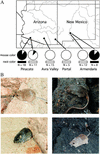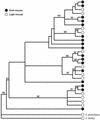The genetic basis of adaptive melanism in pocket mice
- PMID: 12704245
- PMCID: PMC154334
- DOI: 10.1073/pnas.0431157100
The genetic basis of adaptive melanism in pocket mice
Abstract
Identifying the genes underlying adaptation is a major challenge in evolutionary biology. Here, we describe the molecular changes underlying adaptive coat color variation in a natural population of rock pocket mice, Chaetodipus intermedius. Rock pocket mice are generally light-colored and live on light-colored rocks. However, populations of dark (melanic) mice are found on dark lava, and this concealing coloration provides protection from avian and mammalian predators. We conducted association studies by using markers in candidate pigmentation genes and discovered four mutations in the melanocortin-1-receptor gene, Mc1r, that seem to be responsible for adaptive melanism in one population of lava-dwelling pocket mice. Interestingly, another melanic population of these mice on a different lava flow shows no association with Mc1r mutations, indicating that adaptive dark color has evolved independently in this species through changes at different genes.
Figures



References
-
- Lewontin R C. The Genetic Basis of Evolutionary Change. New York: Columbia Univ. Press; 1974.
-
- Orr H A, Coyne J A. Am Nat. 1992;140:725–742. - PubMed
-
- Majerus M E N. Melanism: Evolution in Action. New York: Oxford Univ. Press; 1998.
Publication types
MeSH terms
Substances
Associated data
- Actions
- Actions
- Actions
- Actions
- Actions
- Actions
- Actions
- Actions
- Actions
- Actions
- Actions
- Actions
- Actions
- Actions
- Actions
- Actions
- Actions
- Actions
- Actions
- Actions
- Actions
- Actions
- Actions
- Actions
- Actions
- Actions
- Actions
- Actions
- Actions
- Actions
- Actions
- Actions
- Actions
- Actions
- Actions
- Actions
- Actions
- Actions
- Actions
- Actions
- Actions
- Actions
- Actions
- Actions
- Actions
- Actions
- Actions
- Actions
- Actions
- Actions
- Actions
- Actions
- Actions
- Actions
- Actions
- Actions
- Actions
- Actions
- Actions
- Actions
- Actions
- Actions
- Actions
- Actions
- Actions
- Actions
- Actions
- Actions
- Actions
- Actions
- Actions
- Actions
- Actions
- Actions
- Actions
- Actions
- Actions
- Actions
- Actions
- Actions
- Actions
- Actions
- Actions
- Actions
- Actions
- Actions
- Actions
- Actions
- Actions
- Actions
- Actions
- Actions
- Actions
- Actions
- Actions
- Actions
- Actions
- Actions
- Actions
- Actions
- Actions
- Actions
- Actions
- Actions
- Actions
- Actions
- Actions
- Actions
- Actions
- Actions
- Actions
- Actions
- Actions
- Actions
- Actions
- Actions
- Actions
- Actions
- Actions
- Actions
- Actions
- Actions
- Actions
- Actions
- Actions
- Actions
- Actions
- Actions
- Actions
- Actions
- Actions
- Actions
- Actions
- Actions
- Actions
- Actions
- Actions
- Actions
- Actions
- Actions
- Actions
- Actions
- Actions
- Actions
- Actions
- Actions
- Actions
- Actions
- Actions
- Actions
- Actions
- Actions
- Actions
- Actions
- Actions
- Actions
- Actions
- Actions
- Actions
- Actions
- Actions
- Actions
- Actions
- Actions
- Actions
LinkOut - more resources
Full Text Sources
Other Literature Sources

